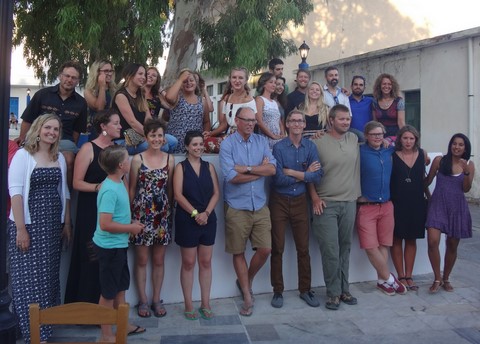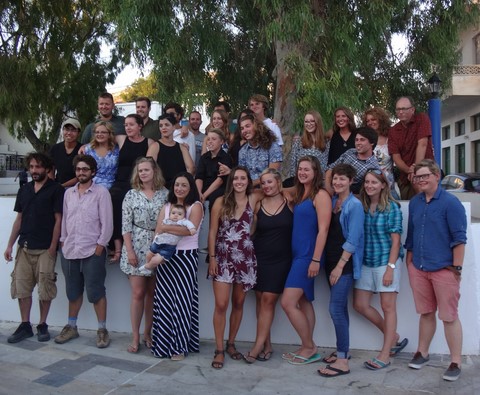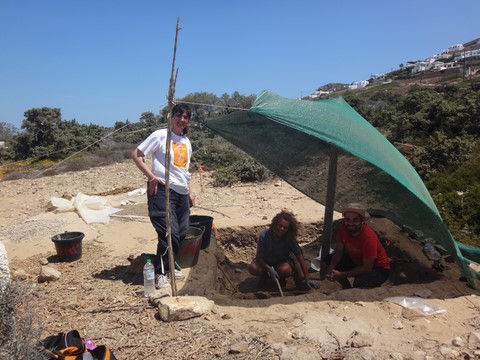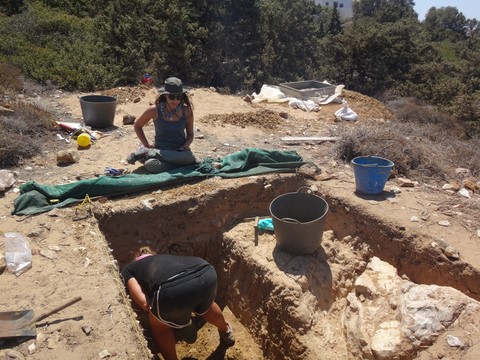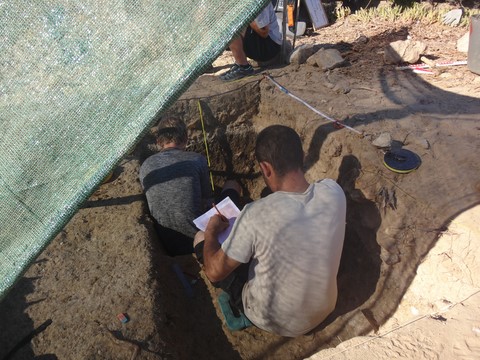Alfred de Grazia's seafaring Neanderthals of Stelida, Naxos
by Anne-Marie de Grazia
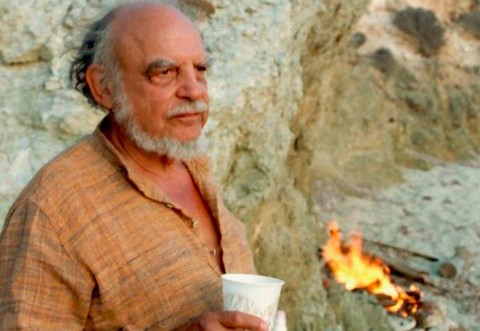
Alfred de Grazia, my husband, died on July 13th, 2014. Only hours before dying, in great spirits and full of plans as always, he asked me to arrange for us to arrive at our home on Stelida, Naxos, by August 8th, an injunction which I was to follow faithfully, albeit alone. Exactly one month after his demise, August 13th, I found myself there, on Stelida, the conic mountain and promontory jutting out into the Aegean Sea from the West coast of the island of Naxos in the Cyclades. I was in the company of my friends, Rosamaria Rossi and her husband, Richard Stern, of Bergamo, Italy.
That day, around noon, I had just come back from buying groceries in the nearby main town, when Rosamaria signalled to me that strange things seemed to be going on near our fence, at the edge of the property. People were surveying the land and planting little red flags. I could indeed make out, inside the fence, two silhouettes, lightly clad in the scorching heat, using a theodolite. Somewhat alarmed, I walked out towards them and was surprised, and also a little bit relieved, to hear that they seemed to be addressing each other in English - at least, these were not some representatives of Greek authorities on a mission of dispossession. I asked them - in my broken Greek, so as to signify to them my rightful presence in the place - and with as severe a mien as I could muster - what they were doing in my garden? They answered, a bit sheepishly, first in broken Greek, and then, with relief, when it became obvious that none of us was a native, in English, that they were carrying out an archaeological survey. Palaeolithic stone tools, of the Levallois type, had been found in this place. They might be attributed to the Neanderthals, and some of them might even date back to Homo Heidelbergensis, i.e., Homo Erectus. To be told in one breath that Neanderthals and Homo erectus may have been busying themselves in your garden - that took a big gulp to swallow! I told the two surveyors, one tall, lanky male and a thin, athletic and sun-burned female, to please come to my house to drink a glass of water after they finished what they were doing. It took them only a few minutes, and they appeared on the terrasse and we all sat down around the round table, in the shade of the bamboo roof.
They reiterated their news, which were astonishing. Even more so for me, if possible, given that they came so close on the heels of Al's departure. But for this, he should have been sitting there with us and exploded in surprise, at this very moment. As it were, his absence was overwhelming. I could hear him split up, laughing in triumph and disbelief. Nothing - absolutely nothing could have struck him more and thrown him into enthusiasm than to hear about this discovery, on his "own" Stelida, which he had so to speak "discovered," in a mad strike, some 45 years earlier. I told the history of the place to our visitors. The tall man was Tristan Carter, of McMaster University in Hamilton, Ontario, Canada, and he was the leader of the project, which had been given the green light by the Greek archaeological authorities, to carry on excavations, over a preliminary period of three years, on the promontory of Stelida. The thin, athletic woman was his assistant, a Serbian. An international team had been assembled. They had started surveying the land during the summer before, in July 2013, when, exceptionally, we had not been at hand - Al, then 93, had decided that it was high time to discover Russia, and to visit our friends there.
The team around Prof. Carter was, at present, in the process of dividing up the mountain in 10 meter squares, which they were staking out with little red flags. I had, indeed, found a few of those among the bushes. The archaeologists conceded that their presence might not be absolutely welcome to everybody on the promontory. Getting authorization from the owners had been obviously left to them, and Prof. Carter had to determine where it would be most profitable to start digging.
I was fully decided to assist them in every way I could - how could I not have? Notwithstanding the somewhat sneaky way with which the survey had been undertaken - I had a good idea of what their problems were, and I knew that Al would not have acted in any other way than they did, or than I was doing. A notoriously impatient man, one of his mottoes was: “If you wait for everything to be perfect, you’ll never do anything.” So, you start the survey, and let's see if someone will kick you out. And: when faced with the extraordinary, normal considerations must be thrown to the winds... So, somewhat trespassed on my land... so what?
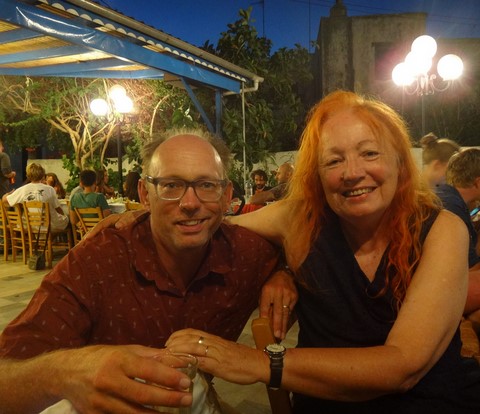
A few days later, I brought Prof. Carter and members of his team, together with Rosamaria and Richard, to a spot which I thought might be a promising one for prehistoric evidence: some small clay-pits on a saddle, up the mountain, all traces of which seemed to have been lost, even on geological maps. We found them after much erring, and after having torn ourselves to shreds on the bushes. Nothing was ever found there. If the pits had indeed been exposed and accessible at the time when the makers of the tools were plying their trade, the art of pottery was still many millennia off...
In the following months, I gave Tristan Carter full authorisation to excavate the property on Stelida, consisting of the land around the house, as well as another piece of land high up the mountain, and I furnished him with the official GPS surveys which were in my possession. I also signalled to Tristan the PhD thesis in geology of our deceased German neighbor and friend, Gerd Rösler, and put him in touch with his widow, whose grandsons had been making bouquets with the red flags planted on her property. In the weeks and months that followed, she, together with one of her neighbors, as well as my neighbor up the mountain, also gave their authorizations for excavations to be made on their properties. The neighbor above had bought his land from Al, and it comprised a high, short cave of shiny, reddish silicate, in which would be found a palaeolithic hearth site.
Al had bought this large tract of land on the desert promontory of Stelida in the late 1960s-early 1970s. There were no roads on Stelida then besides donkey paths and goat paths, there was of course no electricity, no running water, no telephone, and there were no inhabitants, except for his friend, the widowed goat-herd, who lived in a hovel such as could have been visited, unchanged, by Odysseus: it was built with stones and wood around some large, monolithic rocks and surrounded with a corral for the goats. It no longer exists: his nephews built a large bungalow-hotel over the space. Al and I spent several months on Stelida every year, in the company of the wind and the waves, and receiving the occasional visit of some goats. Al kept the full Encyclopaedia Britannica in his study. To build his little stone cabin, Al had had a road opened with a bulldozer. Water, electricity and the telephone arrived in 1990, after Al had sold some of his land to powerful local citizens to build their dream-houses there.
Archaeological trenches were dug on Stelida during the summer of 2015, and expanded in 2016 and 2017. They yielded an astounding amount of material: one archaeologist told me that he had just come from a dig in Spain, and that he had found, in the trench dug close to my house, as much material in two hours as he had found in Spain in three weeks. I made myself popular with the team by giving them the use of a bathroom for showering and a refrigerator, and a shed for their tools. They were all real darlings - bright and eager, and young and beautiful. Greeks, Canadians, Brits, Americans, Serbians... In their own way, maybe that the Neanderthals who had been chipping away enthusiastically on their stones in these very same spots had not been much different.
One of the trenches excavated near Al's original cabin yielded last year the “earliest evidence of a human presence on any island in the Mediterranean." The round of tests is still in process and the final articles are in preparation.
Anne-Marie de Grazia
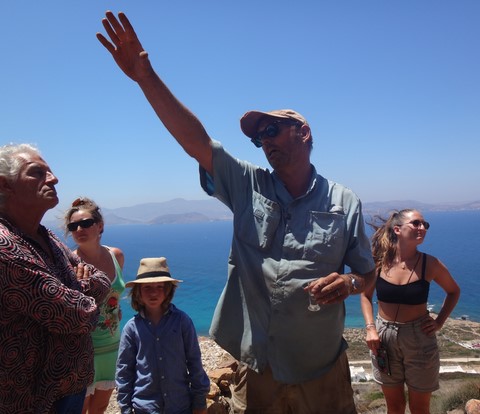
https://stelida.mcmaster.ca/ the official site of the dig
Preliminary articles by Tristan Carter:
Characterization of siliceous rocks at Stelida
Tristan Carter at Stelida
Links to articles - a few of the slew
http://www.dayofarchaeology.com/neanderthals-on-naxos-greece/
https://www.archaeology.wiki/blog/2015/05/26/evidence-neanderthals-greek-island-naxos/
http://aia-stanford.org/TristanCarter.html
https://anthropology.net/2017/01/01/neanderthals-on-a-boat/
http://www.bradshawfoundation.com/news/archaeology.php?id=Seafaring-Neanderthals
https://archaeologynewsnetwork.blogspot.com/2015/05/findings-indicate-existence-of.html#ZSCVh3IKSyLbTjrk.97
http://www.sis-group.org.uk/news/naxos.htm
https://www.ellines.com/en/good-news/20939-ereuna-apedeixe-tin-uparxi-neantertal-sti-naxo/
https://core.tdar.org/document/397325/neanderthals-on-naxos-new-work-at-the-early-prehistoric-chert-source-of-stelida
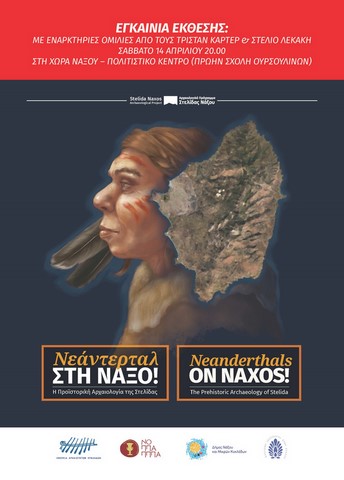
"Neanderthals on Naxos" exhibition at the Municipal Center, Naxos, 2018 (poster)
http://globalarchaeology.ca/the-digs/stelida-naxos-archaeological-project-naxos-greece/
http://www.cig-icg.gr/fr/node/1120
http://www.sciences-faits-histoires.com/blog/preuves-autre-histoire/des-neandertaliens-dans-un-bateau-les-preuves-pointent.html
http://chronique.efa.gr/index.php/fiches/voir/5066/
http://www.ancient-origins.net/news-history-archaeology/new-research-suggests-neanderthal-knowledge-led-them-caves-out-sea-009954
http://greece.greekreporter.com/2015/05/22/new-study-suggests-theory-of-early-humans-in-naxos/
https://www.researchgate.net/profile/Sean_Doyle2/publication/266002800_The_Stelida_Naxos_Archaeological_Project_New_data_on_the_Middle_Palaeolithic_and_Mesolithic_Cyclades/links/5422c98d0cf290c9e3ac7dbc/The-Stelida-Naxos-Archaeological-Project-New-data-on-the-Middle-Palaeolithic-and-Mesolithic-Cyclades.pdf
http://www.messagetoeagle.com/neanderthalsnaxos.php#.Ww1bSrgS-VM
http://www.ancientworldreview.com/2015/05/evidence-of-neanderthals-found-on-naxos-island-greece.htmlhttp://www.thesecretgreece.gr/eng/product/Appearance-Neanderthal-Naxos
http://arkeofili.com/neandertaller-deniz-seyahati-yaparak-ege-adalarina-ulasmis-olabilir/
http://aegeanvoice1075.com/2018/04/15/dr-t-carter-na-eiste-yperifanoi-gia-tin-anakalypsi-ton-neanderthals-sti-stelida/
http://naxos365.blogspot.com/2014/06/stelida-naxos-archaeological-project.html
https://netnature.wordpress.com/2017/03/17/neandertais-em-um-barco/
http://www.archetai.gr/media/PDF/C/777.pdf
http://www.saperescienza.it/news/storia-archeologia/neanderthal-navigatori-del-mediterraneo-17-05-2018/2013-neanderthal-navigatori-del-mediterraneo-17-05-2018
http://www.naxostimes.gr/naxos/14849-oi-neaterntal-tis-stelidas-naksou-borei-na-anatrepsoun-tin-pagkosmia-proistoria-video
http://aquatic-human-ancestor.org/evidence/archaeological-evidence.html
The SNAP crews
